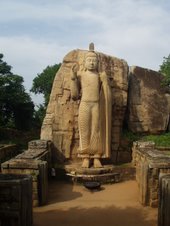
This is an example of some of the fruits that were given to the monks (hamudhuruva in Singhalese) as part of the pirith. Note how each plate is covered by a banana leaf. All the cutlery was supplied by the temple (pansala) that the monks came from. This is because the monks need to use plain, unadorned belongings in accord with the quasi-ascetic Buddhist practices associated with lessening desire.

Preparing for the pirith. In accord with Buddhist custom, the monks are required to sit on chairs with white coverings. Again, this is an ascetic matter - ordinary chairs are too ostenatious. The central table is where the food is arranged. The bronze lamp to the right is not part of the pirith but is a ritual item in other secular Singalese activities.

This is an example of some of the curries that were given to the monks. It is also a good example of Sri Lankan food in general. Some of the dishes here include: breadfruit, anchovies, soy, dhal (lentils), fish, gotu kola (a kind of green), thalana batu (a kind of vegetable shaped like a grape). Many of the monks were strict vegetarians, however fish and meat is often provided.

Here we are giving the monks their meal. Each person attending the pirith spoons out a dish in a particular ritualistic manner. Sri Lankans are extremely respectful of monks and there are even special ways of speaking to them (the personal pronoun oya - you -is not used with monks instead oba - a polite form of 'you' - can be used, but generally they are reffered to in the third person hamudhuruvane ('monk', e.g. monk, would you like chicken? hamudhuruvane, kukul mas?). The monk closest to the door is the head of the temple and is also fully-ordained - this is obvious from the fact that his head is fully shaved. The monks closer to the camera do not have shaved heads and are therefore not fully ordained. This is probably because they are younger than 20. Also note that the laypeople providing the food are usually dressed in white - this is regarded as a clean colour suitable for Buddhist rituals.
After this ceremony, the monks chant a sacred text thereby conferring a certain degree of protection on the laypeople present. This occurs in tandem with the offering of food (dana) which in-itself is meritorious. For this protection to be attained a thread is passed around which everyone holds while the chanting takes place. A ward is created using the thread and is tied around the right wrist (the right hand being clean - pirisindhu - the left hand is associated with bodilly activities and is therefore apirisindhu -unclean). This is called a pirith noola (pirith string) - see image.
 The pirith noola confers protection from bad luck (avasanava) which usually come in the form of devils (yaksha). However, the string only has power for three days, after which it can be cut off. In practice devout Buddhists often keep the string as long as possible - probably to demonstrate their piousness. I can say as a matter of experience that the string can get quite manky after a few days.
The pirith noola confers protection from bad luck (avasanava) which usually come in the form of devils (yaksha). However, the string only has power for three days, after which it can be cut off. In practice devout Buddhists often keep the string as long as possible - probably to demonstrate their piousness. I can say as a matter of experience that the string can get quite manky after a few days.
It should be added that these practices are essentially 'magical' and are not doctrinally certified, i.e. there is little in the Buddhist texts which actually justifies these kinds of activities and in fact it is only through the commentarial tradition that these acivities are promoted. Furthermore, pirith is a uniquely Sri Lankan activity although other magical Buddhist technologies are present in other Buddhist societies. (For example, Burmese Buddhists have similar ceremonies).

4 comments:
That's really fascinating. I didn't realize that how close one's head is shaved is an indicator for how good of a monk one is. It must be a lot of work to keep one's head shaved all the time. (Wouldn't all that attention to appearance sort of backfire?)
The main idea, as I unbderstand it, is that hair represents a kind of attachment, i.e. you have to style it. But monks don't do a lot of stuff generally, so although it may be a lot of work, it's still SOME kind of work. And for that they are probably happy.
Incidentally, those young monks were - more than likely - podhihamudurava, or young monks, i.e. monks who started when they were very small children.
Sri lankan monks are spreading this pirith noola superstition,please stop it .Buddha has shown the real path...ones future is determined by ones actions.Recently some sri lankan monks went to vietnam and tied these things on the hands of devotees.Sri lankan monks should study buddhism properly,many are engaged in anti buddhist activities.
Pirith Chanting and Pirith Threads have immense power. It can protect the wearer, make him successful by keeping trouble away from him. Of course, Pirith Nul alone won't play a role in that, but it plays a part.
Goal of the Buddhism is to reach Nirvana, but to reach there it's good have all the support including what you can receive via Pirith Nul.
Post a Comment